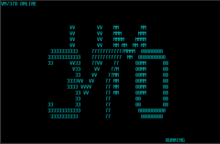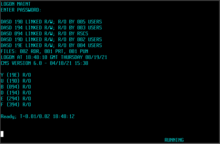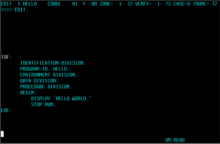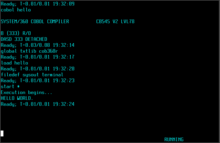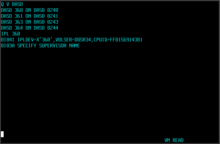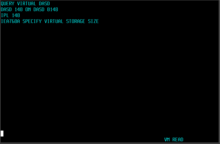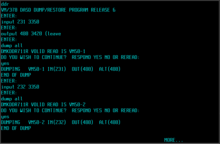In computer operating systems, memory paging (or swapping on some Unix-like systems) is a memory management scheme by which a computer stores and retrieves data from secondary storage for use in main memory. In this scheme, the operating system retrieves data from secondary storage in same-size blocks called pages. Paging is an important part of virtual memory
implementations in modern operating systems, using secondary storage to
let programs exceed the size of available physical memory.
For simplicity, main memory is called "RAM" (an acronym of random-access memory) and secondary storage is called "disk" (a shorthand for hard disk drive, drum memory or solid-state drive, etc.), but as with many aspects of computing, the concepts are independent of the technology used.
Depending on the memory model, paged memory functionality is usually hardwired into a CPU/MCU by using a Memory Management Unit (MMU) or Memory Protection Unit (MPU) and separately enabled by privileged system code in the operating system's kernel. In CPUs implementing the x86 instruction set architecture (ISA) for instance, the memory paging is enabled via the CR0 control register.
History
In the 1960s, swapping was an early virtual memory technique. An entire program or entire segment would be "swapped out" (or "rolled out") from RAM to disk or drum, and another one would be swapped in (or rolled in).
A swapped-out program would be current but its execution would be
suspended while its RAM was in use by another program; a program with a
swapped-out segment could continue running until it needed that segment,
at which point it would be suspended until the segment was swapped in.
A program might include multiple overlays
that occupy the same memory at different times. Overlays are not a
method of paging RAM to disk but merely of minimizing the program's RAM
use. Subsequent architectures used memory segmentation,
and individual program segments became the units exchanged between disk
and RAM. A segment was the program's entire code segment or data
segment, or sometimes other large data structures. These segments had to
be contiguous when resident in RAM, requiring additional computation and movement to remedy fragmentation.
Ferranti's Atlas, and the Atlas Supervisor developed at the University of Manchester,
(1962), was the first system to implement memory paging. Subsequent
early machines, and their operating systems, supporting paging include
the IBM M44/44X and its MOS operating system (1964), the SDS 940 and the Berkeley Timesharing System (1966), a modified IBM System/360 Model 40 and the CP-40 operating system (1967), the IBM System/360 Model 67 and operating systems such as TSS/360 and CP/CMS (1967), the RCA 70/46 and the Time Sharing Operating System (1967), the GE 645 and Multics (1969), and the PDP-10 with added BBN-designed paging hardware and the TENEX operating system (1969).
Those machines, and subsequent machines supporting memory paging, use either a set of page address registers or in-memory page tables to allow the processor to operate on arbitrary pages anywhere in RAM as a seemingly contiguous logical address space. These pages became the units exchanged between disk and RAM.
Page faults
When a process tries to reference a page not currently mapped to a page frame in RAM, the processor treats this invalid memory reference as a page fault and transfers control from the program to the operating system. The operating system must:
- Determine whether a stolen page frame still contains an unmodified copy of the page; if so, use that page frame.
- Otherwise, obtain an empty page frame in RAM to use as a container for the data, and:
- Determine whether the page was ever initialized
- If so determine the location of the data on disk.
- Load the required data into the available page frame.
- Update the page table to refer to the new page frame.
- Return control to the program, transparently retrying the instruction that caused the page fault.
When all page frames are in use, the operating system must select a
page frame to reuse for the page the program now needs. If the evicted
page frame was dynamically allocated
by a program to hold data, or if a program modified it since it was
read into RAM (in other words, if it has become "dirty"), it must be
written out to disk before being freed. If a program later references
the evicted page, another page fault occurs and the page must be read
back into RAM.
The method the operating system uses to select the page frame to reuse, which is its page replacement algorithm, is important to efficiency. The operating system predicts the page frame least likely to be needed soon, often through the least recently used (LRU) algorithm or an algorithm based on the program's working set.
To further increase responsiveness, paging systems may predict which
pages will be needed soon, preemptively loading them into RAM before a
program references them, and may steal page frames from pages that have
been unreferenced for a long time, making them available. Some systems
clear new pages to avoid data leaks that compromise security; some set
them to installation defined or random values to aid debugging.
Page fetching techniques
- Demand paging
- When pure demand paging is used, pages are loaded only when they
are referenced. A program from a memory mapped file begins execution
with none of its pages in RAM. As the program commits page faults, the
operating system copies the needed pages from a file, e.g., memory-mapped file, paging file, or a swap partition containing the page data into RAM.
- Anticipatory paging
- Some systems use only demand paging—waiting until a page is actually requested before loading it into RAM.
- Other systems attempt to reduce latency by guessing which pages
not in RAM are likely to be needed soon, and pre-loading such pages into
RAM, before that page is requested. (This is often in combination with
pre-cleaning, which guesses which pages currently in RAM are not likely
to be needed soon, and pre-writing them out to storage).
- When a page fault occurs, anticipatory paging systems will not
only bring in the referenced page, but also other pages that are likely
to be referenced soon. A simple anticipatory paging algorithm will
bring in the next few consecutive pages even though they are not yet
needed (a prediction using locality of reference); this is analogous to a prefetch input queue in a CPU. Swap prefetching will prefetch recently swapped-out pages if there are enough free pages for them.[7]
- If a program ends, the operating system may delay freeing its pages, in case the user runs the same program again.
Page replacement techniques
- Free page queue, stealing, and reclamation
- The free page queue is a list of page frames that are available for
assignment. Preventing this queue from being empty minimizes the
computing necessary to service a page fault. Some operating systems
periodically look for pages that have not been recently referenced and
then free the page frame and add it to the free page queue, a process
known as "page stealing". Some operating systems support page reclamation;
if a program commits a page fault by referencing a page that was
stolen, the operating system detects this and restores the page frame
without having to read the contents back into RAM.
- Pre-cleaning
- The operating system may periodically pre-clean dirty pages: write
modified pages back to disk even though they might be further modified.
This minimizes the amount of cleaning needed to obtain new page frames
at the moment a new program starts or a new data file is opened, and
improves responsiveness. (Unix operating systems periodically use sync to pre-clean all dirty pages; Windows operating systems use "modified page writer" threads.)
Thrashing
After completing initialization, most programs operate on a small
number of code and data pages compared to the total memory the program
requires. The pages most frequently accessed are called the working set.
When the working set is a small percentage of the system's total
number of pages, virtual memory systems work most efficiently and an
insignificant amount of computing is spent resolving page faults. As the
working set grows, resolving page faults remains manageable until the
growth reaches a critical point. Then faults go up dramatically and the
time spent resolving them overwhelms time spent on the computing the
program was written to do. This condition is referred to as thrashing.
Thrashing occurs on a program that works with huge data structures, as
its large working set causes continual page faults that drastically slow
down the system. Satisfying page faults may require freeing pages that
will soon have to be re-read from disk. "Thrashing" is also used in
contexts other than virtual memory systems; for example, to describe cache issues in computing or silly window syndrome in networking.
A worst case might occur on VAX
processors. A single MOVL crossing a page boundary could have a source
operand using a displacement deferred addressing mode, where the
longword containing the operand address crosses a page boundary, and a
destination operand using a displacement deferred addressing mode, where
the longword containing the operand address crosses a page boundary,
and the source and destination could both cross page boundaries. This
single instruction references ten pages; if not all are in RAM, each
will cause a page fault. As each fault occurs the operating system needs
to go through the extensive memory management routines perhaps causing
multiple I/Os which might include writing other process pages to disk
and reading pages of the active process from disk. If the operating
system could not allocate ten pages to this program, then remedying the
page fault would discard another page the instruction needs, and any
restart of the instruction would fault again.
To decrease excessive paging and resolve thrashing problems, a
user can increase the number of pages available per program, either by
running fewer programs concurrently or increasing the amount of RAM in
the computer.
Sharing
In multi-programming or in a multi-user
environment, many users may execute the same program, written so that
its code and data are in separate pages. To minimize RAM use, all users
share a single copy of the program. Each process's page table
is set up so that the pages that address code point to the single
shared copy, while the pages that address data point to different
physical pages for each process.
Different programs might also use the same libraries. To save
space, only one copy of the shared library is loaded into physical
memory. Programs which use the same library have virtual addresses that
map to the same pages (which contain the library's code and data). When
programs want to modify the library's code, they use copy-on-write, so memory is only allocated when needed.
Shared memory is an efficient means of communication between
programs. Programs can share pages in memory, and then write and read to
exchange data.
Implementations
Ferranti Atlas
The first computer to support paging was the supercomputer Atlas, jointly developed by Ferranti, the University of Manchester and Plessey in 1963. The machine had an associative (content-addressable) memory with one entry for each 512 word page. The Supervisor handled non-equivalence interruptions and managed the transfer of pages between core and drum in order to provide a one-level store to programs.
Microsoft Windows
Windows 3.x and Windows 9x
Paging has been a feature of Microsoft Windows since Windows 3.0 in 1990. Windows 3.x creates a hidden file named 386SPART.PAR or WIN386.SWP for use as a swap file. It is generally found in the root directory,
but it may appear elsewhere (typically in the WINDOWS directory). Its
size depends on how much swap space the system has (a setting selected
by the user under Control Panel → Enhanced under "Virtual Memory"). If the user moves or deletes this file, a blue screen will appear the next time Windows is started, with the error message
"The permanent swap file is corrupt". The user will be prompted to
choose whether or not to delete the file (even if it does not exist).
Windows 95, Windows 98 and Windows Me
use a similar file, and the settings for it are located under Control
Panel → System → Performance tab → Virtual Memory. Windows automatically
sets the size of the page file to start at 1.5× the size of physical
memory, and expand up to 3× physical memory if necessary. If a user runs
memory-intensive applications on a system with low physical memory, it
is preferable to manually set these sizes to a value higher than
default.
Windows NT
The file used for paging in the Windows NT family is pagefile.sys.
The default location of the page file is in the root directory of the
partition where Windows is installed. Windows can be configured to use
free space on any available drives for page files. It is required,
however, for the boot partition (i.e., the drive containing the Windows
directory) to have a page file on it if the system is configured to
write either kernel or full memory dumps after a Blue Screen of Death.
Windows uses the paging file as temporary storage for the memory dump.
When the system is rebooted, Windows copies the memory dump from the
page file to a separate file and frees the space that was used in the
page file.
Fragmentation
In the default configuration of Windows, the page file is allowed to
expand beyond its initial allocation when necessary. If this happens
gradually, it can become heavily fragmented which can potentially cause performance problems.
The common advice given to avoid this is to set a single "locked" page
file size so that Windows will not expand it. However, the page file
only expands when it has been filled, which, in its default
configuration, is 150% of the total amount of physical memory.
Thus the total demand for page file-backed virtual memory must exceed
250% of the computer's physical memory before the page file will expand.
The fragmentation of the page file that occurs when it expands is
temporary. As soon as the expanded regions are no longer in use (at the
next reboot, if not sooner) the additional disk space allocations are
freed and the page file is back to its original state.
Locking a page file size can be problematic if a Windows
application requests more memory than the total size of physical memory
and the page file, leading to failed requests to allocate memory that
may cause applications and system processes to fail. Also, the page file
is rarely read or written in sequential order, so the performance
advantage of having a completely sequential page file is minimal.
However, a large page file generally allows the use of memory-heavy
applications, with no penalties besides using more disk space. While a
fragmented page file may not be an issue by itself, fragmentation of a
variable size page file will over time create several fragmented blocks
on the drive, causing other files to become fragmented. For this reason,
a fixed-size contiguous page file is better, providing that the size
allocated is large enough to accommodate the needs of all applications.
The required disk space may be easily allocated on systems with
more recent specifications (i.e. a system with 3 GB of memory having a
6 GB fixed-size page file on a 750 GB disk drive, or a system with 6
GB of memory and a 16 GB fixed-size page file and 2 TB of disk space).
In both examples, the system uses about 0.8% of the disk space with the
page file pre-extended to its maximum.
Defragmenting
the page file is also occasionally recommended to improve performance
when a Windows system is chronically using much more memory than its
total physical memory.
This view ignores the fact that, aside from the temporary results of
expansion, the page file does not become fragmented over time. In
general, performance concerns related to page file access are much more
effectively dealt with by adding more physical memory.
Unix and Unix-like systems
Unix systems, and other Unix-like operating systems, use the term "swap" to describe the act of substituting disk space for RAM when physical RAM is full. In some of those systems, it is common to dedicate an entire partition of a hard disk to swapping. These partitions are called swap partitions.
Many systems have an entire hard drive dedicated to swapping, separate
from the data drive(s), containing only a swap partition. A hard drive
dedicated to swapping is called a "swap drive" or a "scratch drive" or a
"scratch disk". Some of those systems only support swapping to a swap partition; others also support swapping to files.
Linux
The Linux kernel supports a virtually unlimited number of swap
backends (devices or files), and also supports assignment of backend
priorities. When the kernel swaps pages out of physical memory, it uses
the highest-priority backend with available free space. If multiple swap
backends are assigned the same priority, they are used in a round-robin fashion (which is somewhat similar to RAID 0 storage layouts), providing improved performance as long as the underlying devices can be efficiently accessed in parallel.
Swap files and partitions
From
the end-user perspective, swap files in versions 2.6.x and later of the
Linux kernel are virtually as fast as swap partitions; the limitation
is that swap files should be contiguously allocated on their underlying
file systems. To increase performance of swap files, the kernel keeps a
map of where they are placed on underlying devices and accesses them
directly, thus bypassing the cache and avoiding filesystem overhead.
When residing on HDDs, which are rotational magnetic media devices, one
benefit of using swap partitions is the ability to place them on
contiguous HDD areas that provide higher data throughput or faster seek
time. However, the administrative flexibility of swap files can outweigh
certain advantages of swap partitions. For example, a swap file can be
placed on any mounted file system, can be set to any desired size, and
can be added or changed as needed. Swap partitions are not as flexible;
they cannot be enlarged without using partitioning or volume management tools, which introduce various complexities and potential downtimes.
Swappiness
Swappiness is a Linux kernel parameter that controls the relative weight given to swapping out of runtime memory, as opposed to dropping pages from the system page cache, whenever a memory allocation request cannot be met from free memory. Swappiness can be set to a value from 0 to 200.
A low value causes the kernel to prefer to evict pages from the page
cache while a higher value causes the kernel to prefer to swap out
"cold" memory pages. The default value is 60;
setting it higher can cause high latency if cold pages need to be
swapped back in (when interacting with a program that had been idle for
example), while setting it lower (even 0) may cause high latency when
files that had been evicted from the cache need to be read again, but
will make interactive programs more responsive as they will be less
likely to need to swap back cold pages. Swapping can also slow down HDDs further because it involves a lot of random writes, while SSDs
do not have this problem. Certainly the default values work well in
most workloads, but desktops and interactive systems for any expected
task may want to lower the setting while batch processing and less
interactive systems may want to increase it.
Swap death
When
the system memory is highly insufficient for the current tasks and a
large portion of memory activity goes through a slow swap, the system
can become practically unable to execute any task, even if the CPU is
idle. When every process is waiting on the swap, the system is
considered to be in swap death.
Swap death can happen due to incorrectly configured memory overcommitment.
The original description of the "swapping to death" problem relates to the X server.
If code or data used by the X server to respond to a keystroke is not
in main memory, then if the user enters a keystroke, the server will
take one or more page faults, requiring those pages to read from swap
before the keystroke can be processed, slowing the response to it. If
those pages don't remain in memory, they will have to be faulted in
again to handle the next keystroke, making the system practically
unresponsive even if it's actually executing other tasks normally.
macOS
macOS
uses multiple swap files. The default (and Apple-recommended)
installation places them on the root partition, though it is possible to
place them instead on a separate partition or device.
AmigaOS 4
AmigaOS 4.0
introduced a new system for allocating RAM and defragmenting physical
memory. It still uses flat shared address space that cannot be
defragmented. It is based on slab allocation method and paging memory that allows swapping. Paging was implemented in AmigaOS 4.1 but may lock up system if all physical memory is used up. Swap memory could be activated and deactivated any moment allowing the user to choose to use only physical RAM.
Performance
The backing store for a virtual memory operating system is typically many orders of magnitude slower than RAM. Additionally, using mechanical storage devices introduces delay,
several milliseconds for a hard disk. Therefore, it is desirable to
reduce or eliminate swapping, where practical. Some operating systems
offer settings to influence the kernel's decisions.
- Linux offers the
/proc/sys/vm/swappiness parameter, which changes the balance between swapping out runtime memory, as opposed to dropping pages from the system page cache. - Windows 2000, XP, and Vista offer the
DisablePagingExecutive registry setting, which controls whether kernel-mode code and data can be eligible for paging out. - Mainframe computers frequently used head-per-track disk drives or
drums for page and swap storage to eliminate seek time, and several
technologies to have multiple concurrent requests to the same device in order to reduce rotational latency.
- Flash memory has a finite number of erase-write cycles (see limitations of flash memory), and the smallest amount of data that can be erased at once might be very large (128 KiB for an Intel X25-M SSD ),
seldom coinciding with pagesize. Therefore, flash memory may wear out
quickly if used as swap space under tight memory conditions. On the
attractive side, flash memory is practically delayless compared to hard
disks, and not volatile as RAM chips. Schemes like ReadyBoost and Intel Turbo Memory are made to exploit these characteristics.
Many Unix-like operating systems (for example AIX, Linux, and Solaris) allow using multiple storage devices for swap space in parallel, to increase performance.
Swap space size
In
some older virtual memory operating systems, space in swap backing
store is reserved when programs allocate memory for runtime data.
Operating system vendors typically issue guidelines about how much swap
space should be allocated.
Addressing limits on 32-bit hardware
Paging
is one way of allowing the size of the addresses used by a process,
which is the process's "virtual address space" or "logical address
space", to be different from the amount of main memory actually
installed on a particular computer, which is the physical address space.
Main memory smaller than virtual memory
In most systems, the size of a process's virtual address space is much larger than the available main memory. For example:
- The address bus that connects the CPU to main memory may be limited. The i386SX CPU's
32-bit internal addresses can address 4 GB, but it has only 24 pins
connected to the address bus, limiting installed physical memory to
16 MB. There may be other hardware restrictions on the maximum amount of
RAM that can be installed.
- The maximum memory might not be installed because of cost, because
the model's standard configuration omits it, or because the buyer did
not believe it would be advantageous.
- Sometimes not all internal addresses can be used for memory anyway,
because the hardware architecture may reserve large regions for I/O or
other features.
Main memory the same size as virtual memory
A computer with true n-bit addressing may have 2n addressable units of RAM installed. An example is a 32-bit x86 processor with 4 GB and without Physical Address Extension (PAE). In this case, the processor is able to address all the RAM installed and no more.
However, even in this case, paging can be used to create a
virtual memory of over 4 GB. For instance, many programs may be running
concurrently. Together, they may require more than 4 GB, but not all of
it will have to be in RAM at once. A paging system makes efficient
decisions on which memory to relegate to secondary storage, leading to
the best use of the installed RAM.
Although the processor in this example cannot address RAM beyond
4 GB, the operating system may provide services to programs that
envision a larger memory, such as files that can grow beyond the limit
of installed RAM. The operating system lets a program manipulate data in
the file arbitrarily, using paging to bring parts of the file into RAM
when necessary.
Main memory larger than virtual address space
A few computers have a main memory larger than the virtual address space of a process, such as the Magic-1, some PDP-11 machines, and some systems using 32-bit x86 processors with Physical Address Extension.
This nullifies a significant advantage of paging, since a single
process cannot use more main memory than the amount of its virtual
address space. Such systems often use paging techniques to obtain
secondary benefits:
- The "extra memory" can be used in the page cache to cache frequently used files and metadata, such as directory information, from secondary storage.
- If the processor and operating system support multiple virtual
address spaces, the "extra memory" can be used to run more processes.
Paging allows the cumulative total of virtual address spaces to exceed
physical main memory.
- A process can store data in memory-mapped files on memory-backed file systems, such as the tmpfs file system or file systems on a RAM drive, and map files into and out of the address space as needed.
- A set of processes may still depend upon the enhanced security
features page-based isolation may bring to a multitasking environment.
The size of the cumulative total of virtual address spaces is still limited by the amount of secondary storage available.

